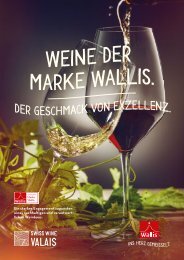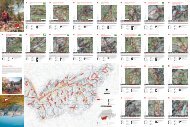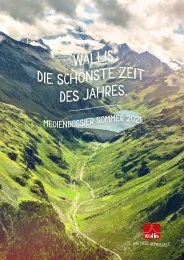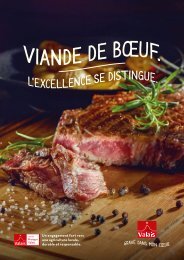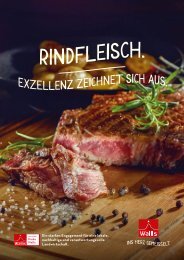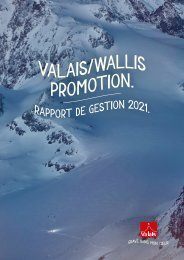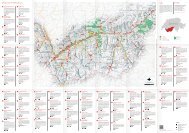Wines of Valais, pure passion.
Create successful ePaper yourself
Turn your PDF publications into a flip-book with our unique Google optimized e-Paper software.
1
2
<strong>Valais</strong> – let your imagination soar.<br />
In <strong>Valais</strong>, the earth is a fertile ground for your imagination. Enter this jewel box <strong>of</strong> a world where<br />
time stands still and you can begin your enchanted escape into a vast visual and sensory feast.<br />
It is impossible not to enjoy the timelessness <strong>of</strong> a region that radiates such beauty. Savour the<br />
sunrise as it sets the glaciers ablaze one by one, then the mountain peaks, forests and terraced<br />
vineyards. Admire the breathtaking scenery. Stroll along the renowned Chemin du Vignoble as<br />
it emerges at dawn with the first rays <strong>of</strong> sunshine warming the dry stone walls as they wind their<br />
majestic way around nearly 5,000 hectares <strong>of</strong> outstanding vineyards.<br />
You will never tire <strong>of</strong> the splendour before you; to travel in haste is to risk missing it. Nature lets<br />
the imagination run riot here, as you wander effortlessly from the old stone village nestled by<br />
the vineyards, through the fruit tree orchards and on to the paths that zigzag up the mountains.<br />
Places like this are true sources <strong>of</strong> inspiration – even the stuff <strong>of</strong> dreams. Throw caution to<br />
the wind and let chance be your guide. <strong>Valais</strong> <strong>Wines</strong>, the hidden jewels <strong>of</strong> <strong>Valais</strong>, await your<br />
discovery. All over the world, wine lovers are eagerly exchanging the names <strong>of</strong> <strong>Valais</strong> wine<br />
producers.<br />
And at the end <strong>of</strong> the day, watch the setting sun, reflected in the glassy Rhone, the lengthening<br />
shadows <strong>of</strong> the mountains and magnificent vines which spill gently over the hillsides in a magical<br />
intimacy <strong>of</strong> pasture and mountain.<br />
Words cannot do justice to these stirring moments where time stands still, which you will<br />
experience when visiting <strong>Valais</strong>, but it will set your heart aflutter, and let your imagination soar...<br />
Under the <strong>Valais</strong> night sky, the breeze will tell its stories and the stars will serve as your guide<br />
as you discover the wines <strong>of</strong> valais!<br />
Lac Geneva<br />
Vouvry<br />
Lausanne<br />
Geneva<br />
Bern<br />
Switzerland<br />
Monthey<br />
Conthey<br />
Vétroz<br />
Ardon<br />
Chamoson<br />
St-Maurice<br />
val<br />
d’illiez<br />
Champéry<br />
Leytron<br />
Ovronnaz<br />
Saillon<br />
Fully<br />
Riddes<br />
Basel<br />
Bern<br />
Zürich<br />
Chamonix<br />
FRANCE<br />
Martigny-<br />
Croix<br />
Martigny<br />
Bovernier<br />
Orsières<br />
Charrat<br />
Saxon<br />
La Tzoumaz<br />
Verbier<br />
val de<br />
bagnes<br />
Lausanne<br />
Chur<br />
4<br />
Geneva<br />
Sion/Sitten<br />
Bellinzona<br />
Great St Bernard Pass<br />
Aoste<br />
ITALY
Rhone<br />
Glacier<br />
Furka<br />
Pass<br />
Bern<br />
Zürich<br />
lötschental<br />
Aletsch<br />
Glacier<br />
goms<br />
The Rhone<br />
Crans-Montana<br />
Anzère<br />
Leukerbad<br />
Leuk<br />
Varen<br />
Miège<br />
Venthône<br />
Veyras<br />
Lötschberg<br />
Gampel<br />
Raron<br />
Visp<br />
Brig<br />
Simplon<br />
Turtmann<br />
Agarn<br />
Lens<br />
Ayent<br />
Grimisuat<br />
Savièse<br />
Chermignon<br />
Domodossola<br />
ITALY<br />
Sion/Sitten<br />
Veysonnaz<br />
Nendaz<br />
St-Léonard<br />
Grône<br />
Salquenen<br />
Sierre/Siders<br />
Chippis<br />
Chalais<br />
Visperterminen<br />
val<br />
d’hérémence<br />
Evolène<br />
val<br />
d’hérens<br />
Arolla<br />
Vercorin<br />
Grimentz<br />
val<br />
d’anniviers<br />
Zinal<br />
Matterhorn<br />
mattertal<br />
Zermatt<br />
saastal<br />
Simplon Pass<br />
Saas-Fee<br />
The <strong>Valais</strong> vineyards<br />
Wine-producing city/village<br />
The <strong>Valais</strong> Wine Route<br />
Mountain resort<br />
Highway A9<br />
Railway<br />
5
6
<strong>Valais</strong> and its wonderful diversity.<br />
<strong>Valais</strong> is one <strong>of</strong> the most beautiful valleys in the Alps, with<br />
magnificent scenery stretching the length <strong>of</strong> the Rhone as it<br />
winds its way towards Lake Geneva. The canton sits at the<br />
heart <strong>of</strong> the Alps and runs, with the river, from east to west,<br />
and from 400 to 4,000 metres in altitude. The result is an<br />
incredible diversity <strong>of</strong> landscapes and ecosystems. Hikers who<br />
look to either side <strong>of</strong> the paths are quickly enamoured <strong>of</strong> the<br />
rich flora and fauna <strong>of</strong> <strong>Valais</strong>, from the almond trees that <strong>of</strong>ten<br />
burst into flower just before the end <strong>of</strong> the winter, to kaki and<br />
olive trees, harmless Italian scorpions and praying mantises.<br />
<strong>Valais</strong> is like a pyramid. On the Rhone plain it is a land <strong>of</strong><br />
luxuriant gardens and orchards boasting rich alluvial soil.<br />
Climb to the level <strong>of</strong> the vines that hug the steepest slopes, up<br />
to 800 metres – or even 1,000 metres in Vispertal – and study<br />
the plants among the vines and steppe-like brush and bushes<br />
that grow there. Above the vines lie forests and fields, and<br />
higher still, above the tree line, are the high pastures crowned<br />
by the majestic Alpine peaks and their silent, mineral world.<br />
This extraordinary variety runs parallel to the rich and varied<br />
traditions <strong>of</strong> society that have developed here, reflected in<br />
the wealth <strong>of</strong> its culture. Whether it’s winter or summer, the<br />
number <strong>of</strong> options for tourists is enormous, from the broad<br />
spread <strong>of</strong> ski resorts in winter to the varied hiking possibilities<br />
that lead you from mountain paths to lakeside trails.<br />
valais.ch/en/home<br />
Rhone Glacier.<br />
7
A climate similar to the south <strong>of</strong> France.<br />
<strong>Valais</strong>, sitting in the heart <strong>of</strong> the Alps, benefits from an exceptional<br />
steppe climate. The barriers formed by the mountains <strong>of</strong>ten hold<br />
back the rain, creating warm foehn winds that sweep away the clouds,<br />
bringing fine weather and gentle temperatures.<br />
<strong>Valais</strong> is Switzerland’s driest canton, with only 600mm <strong>of</strong> rainfall a year.<br />
With 2,000 hours <strong>of</strong> sunlight, it is also one <strong>of</strong> the most sun-blessed<br />
regions in central Europe. The foehn winds that are frequent in autumn<br />
dry the grapes, help them to ripen and concentrate their sugar, while<br />
simultaneously stopping grey rot. When the foehn drops, local winds,<br />
usually from the side valleys, <strong>of</strong>ten serve the same purpose.<br />
The other key climatic feature is the strong contrast in temperature<br />
between warm days and cool nights. The evening chill helps aromas<br />
develop complexity and delicacy as the grapes reach the end <strong>of</strong> the<br />
ripening process.<br />
<strong>Valais</strong> is also remarkable for the regular rhythm and beauty <strong>of</strong> its<br />
autumns, with sunny days and warm, dry weather, perfect for top quality<br />
sweet late harvest wines that compete happily with the best sweet<br />
wines from anywhere in the world.<br />
Conditions are ideal for these vineyards, which sit at 450 to 800 metres.<br />
There are just two shortcomings to what would otherwise be a heavenly<br />
location for growing grapes: spring frosts – the glaciers are close by –<br />
and dry spells that can last too long in summer. Growers in the past used<br />
the famous bisses (irrigation channels) that trapped mountain streams<br />
and rivers to water the vines. Today’s growers irrigate lightly.<br />
8 Cactus, Beudon, above Fully.
9
10
Soils that are rich and complex.<br />
Geology is the main factor that contributes to the international reputation <strong>of</strong> <strong>Valais</strong> wines.<br />
It’s as rich as it is complex, linked to the emergence and development <strong>of</strong> the Swiss Alps. To<br />
understand this we need to go back several hundred thousand years, into the depths <strong>of</strong> time,<br />
where we can picture the slow formation <strong>of</strong> the continents, tectonic plates colliding, and the<br />
gradual formation <strong>of</strong> the Alpine massif. We need to recall how, over time, these geological<br />
movements created folds, rock slides, mud slides and sharp fissures in rock formations. Add<br />
to this the enormous Rhone Glacier which moved down to Lyon some 15,000 years ago, and<br />
then try to envisage its slow retreat, gradually remodelling the land and slopes leaving rich and<br />
varied deposits in its wake.<br />
Generally speaking, Lower <strong>Valais</strong>, the area from Martigny to Saillon, is mainly granitic, sometimes<br />
covered by loess (calcium deposits built up by the wind), sometimes interwoven with<br />
limestone veins.<br />
Higher up in the canton, the soil is extremely chalky, to a point where people refer to active<br />
limestone. This is an area that starts between Sion and Sierre and stretches to Upper <strong>Valais</strong>,<br />
going as high as vines grow.<br />
Between these two areas we find two types <strong>of</strong> soil: moraines (the debris and rocks carried and<br />
left by glaciers) and shallow soils which sit on chalk or schist (a kind <strong>of</strong> layered, sedimentary<br />
rock that resembles slate).<br />
A final type <strong>of</strong> soil that is important for vines is found on alluvial fans. Formed by alluvial detritus<br />
carried over millennia by the Rhone, it is a pebbly, gravelly soil, well drained, and sometimes<br />
even very dry. It is found the length <strong>of</strong> the <strong>Valais</strong> vineyards, but the most famous <strong>of</strong> the alluvial<br />
fans is La Losentze in Chamoson.<br />
The multitude <strong>of</strong> grape varieties in <strong>Valais</strong> grow on this mosaic <strong>of</strong> different soils. Each variety is<br />
matched to the terroir where it can best express itself. Gamay loves granite, Pinot Noir chalky<br />
soils. The fact that there are several different geological formations in each region <strong>of</strong> the canton<br />
makes it possible for most varieties to find ideal conditions in <strong>Valais</strong>.<br />
View <strong>of</strong> the Matterhorn from Riffelsee lake.<br />
11
A vineyard in terraces.<br />
<strong>Valais</strong> has a multitude <strong>of</strong> soils which are favourable<br />
to growing grapes and its climate is<br />
particularly good for viticulture.<br />
But without man to work the vines, there<br />
would be no wine! The grower and producer<br />
are an integral part <strong>of</strong> the idea <strong>of</strong> “terroir”. As<br />
important as the climate, these people give<br />
their knowledge, skills and intuition to the<br />
process <strong>of</strong> creating excellent wines.<br />
Almost 2,000 years ago the first growers began<br />
to cultivate vines and to establish vine parcels<br />
on the slopes. These terraces, supported by<br />
dry stone walls, were artisanal and ecological<br />
jewels – architectural masterpieces built onto<br />
the rock. Put the terraced vineyards <strong>of</strong> 62<br />
<strong>Valais</strong> communes end to end and you have<br />
more than 3,000 kilometres <strong>of</strong> dry stone walls!<br />
What skill and perseverance it must have taken<br />
to build these walls, which are more than 20<br />
metres high in some places, and to carry the<br />
earth needed to fill the terraced vines! And<br />
what hard labour and high maintenance costs,<br />
as the mechanisation <strong>of</strong> labour is practically<br />
impossible!<br />
12 Terraced vineyards in the hills <strong>of</strong> Sion.
13
14
Our wine producers –<br />
masters <strong>of</strong> spellbinding<br />
wines!<br />
There is not so much a common ground between<br />
nature and our wine producers, as a<br />
world which binds them. In this world, wine<br />
production takes centre stage; an art form<br />
that evolves throughout the seasons.<br />
Wine producers in <strong>Valais</strong> add <strong>passion</strong> into<br />
their wines – a signature expression and hallmark<br />
<strong>of</strong> skill. Their terroirs are their friends.<br />
The stories that they tell us are the stuff <strong>of</strong><br />
poetry. They are on first-name terms with their<br />
vines and know their every nuance intimately,<br />
so as to create an element <strong>of</strong> surprise and<br />
capture dreams in the bottle. They visualise<br />
their wines as a fashion designer does a collection.<br />
Chanel invented allure, Dior elegance<br />
and Saint Laurent style. <strong>Valais</strong> wines embody<br />
all three.<br />
They are always seeking ways to inject <strong>passion</strong><br />
into the mundane. These are the magicians<br />
who enhance our lives and strive to encourage<br />
well-being and good taste. They are the<br />
artists who tantalise the taste buds, and in so<br />
doing prove their remarkable skill and exceptional<br />
talent.<br />
15
Environmentally friendly viticulture.<br />
The vineyards <strong>of</strong> <strong>Valais</strong> are host to a diverse range <strong>of</strong> plant<br />
and animal species, highlighting their unique and distinctive<br />
environment. <strong>Valais</strong> wine producers have been quick to understand<br />
the importance <strong>of</strong> protecting the natural riches on<br />
its hillsides to the best <strong>of</strong> their ability.<br />
For over 30 years now, wine producers have been working<br />
with the <strong>Valais</strong> government to develop sustainable methods<br />
to protect crops. The aim is to limit damage caused to the<br />
vines by pests while also protecting people and the environment.<br />
As a result <strong>of</strong> mating disruption techniques and biological<br />
pest control, insecticides have almost disappeared from<br />
the vineyards <strong>of</strong> <strong>Valais</strong>.<br />
The use <strong>of</strong> herbicides has also been significantly reduced,<br />
with cover cropping in vineyards now becoming more widespread<br />
thanks to new techniques and a better understanding<br />
<strong>of</strong> the balance between the vines and other flora.<br />
In the same vein, advances in scientific research have also<br />
provided effective alternatives to certain problematic treatments<br />
at no risk to humans or the environment.<br />
In <strong>Valais</strong>, wine producers committed to preserving natural resources<br />
and protecting the environment apply the principles<br />
<strong>of</strong> integrated production (IP), which promotes the responsible<br />
use <strong>of</strong> pesticides. The vast majority <strong>of</strong> vineyards now<br />
follow this approach.<br />
16
17
18
The mark <strong>of</strong> sustainability.<br />
Regulated by independent organisations, several labels certify sustainable approaches to wine<br />
growing and/or wine production, guaranteeing transparency for consumers.<br />
Vinatura<br />
Certifies quality, eco-friendly Swiss wines produced according to sustainable<br />
winemaking principles.<br />
vinatura.ch<br />
IP-SUISSE<br />
The ladybird label recognises Swiss products made using integrated production<br />
methods which aim to promote biodiversity and reduce the use <strong>of</strong><br />
pesticides.<br />
ipsuisse.ch<br />
Organic bud label<br />
To achieve and maintain the balance between nature, humans and animals,<br />
organic producers use treatments containing naturally occurring active<br />
ingredients.<br />
bio-suisse.ch<br />
Demeter label or biodynamic production<br />
In addition to organic production and promoting vineyard biodiversity, biodynamic<br />
farming methods commit to revitalising the land and plants, as well<br />
as strengthening animals and people.<br />
demeter.ch<br />
The <strong>Valais</strong> brand<br />
Certifies organically produced wines made using sustainable methods while<br />
respecting people and the local environment.<br />
valais.ch/vinsmarquevalais<br />
19
ALA SELECTION DES VINS DU V<br />
ALA SELECTION DES VINS DU V<br />
The <strong>Valais</strong> Wine Selection…<br />
After several months <strong>of</strong> ageing their wines sheltered from the sun’s rays,<br />
<strong>Valais</strong> winemakers have the opportunity to present their precious gems<br />
before a jury <strong>of</strong> pr<strong>of</strong>essionals at the leading competition for AOC <strong>Valais</strong><br />
wines, the Sélection des Vins du <strong>Valais</strong>.*<br />
Awarded to the top-scoring wines each year, the gold and silver medals<br />
guarantee the highest quality for producers and consumers.<br />
…and its stars.<br />
Petite Arvine, Fendant, Heida, Johannisberg, Cornalin, Humagne Rouge,<br />
Syrah, Dôle<br />
These eight icons shine a little brighter amidst the impressive diversity<br />
<strong>of</strong> <strong>Valais</strong> grape varieties. They deserve to be stars! The Étoile is awarded<br />
to the wine with the best score in each category at the Sélection des<br />
Vins du <strong>Valais</strong>. The eight Étoiles du <strong>Valais</strong> are brought together and sold<br />
as a limited edition collection.<br />
* Competition under the patronage <strong>of</strong> the Swiss Union <strong>of</strong> Oenologists<br />
(USOE) in compliance with the NormeVIN standard, which is based<br />
on current international standards stipulating that the percentage <strong>of</strong><br />
medal-winning wines cannot exceed 30%.<br />
LAIS<br />
LAIS<br />
Médaille d’Or<br />
Médaille d’Argent<br />
20
21
22
The aoc valais.<br />
An aoc (Appellation d’Origine Contrôlée) system with<br />
regulations similar to those used for vines in the European<br />
Union was put in place in <strong>Valais</strong> in 1990. <strong>Wines</strong> are<br />
subject to very strict rules which cover every aspect <strong>of</strong><br />
production that affects quality and character: selecting<br />
appropriate growing areas and grape varieties, grape<br />
yields and minimal sugar levels. These regulations are<br />
tightly controlled, meaning that wines can be clearly<br />
traced, thus ensuring the long-term future <strong>of</strong> grapegrowing<br />
and wine production in <strong>Valais</strong>.<br />
<strong>Valais</strong> grape varieties.<br />
With more than 55 <strong>of</strong>ficial grape varieties across almost<br />
4,750 hectares, <strong>Valais</strong> is an ampelographic haven <strong>of</strong><br />
huge diversity, hosting several native and long-established<br />
grape varieties which produce unique wines on<br />
a global level from a plethora <strong>of</strong> terroirs.<br />
<strong>Valais</strong> grape varieties can be classified into three<br />
groups: native varieties which probably originated<br />
there, traditional varieties established prior to 1900,<br />
and the non-native varieties introduced after 1900.<br />
These are set out below in order <strong>of</strong> decreasing surface<br />
area. (2022 area records compiled by the <strong>Valais</strong> regional<br />
government, <strong>of</strong>fice for viticulture.)<br />
23
Grape varieties in <strong>Valais</strong> – Native varieties – Whites.<br />
Name Etymology Ancestry<br />
Petite Arvine<br />
or Arvine<br />
252 ha<br />
Latin arvena = recently arrived,<br />
introduced, name may be derived<br />
from its ancient introduction<br />
Orphan grape variety, grandparent <strong>of</strong> the extremely<br />
rare Grosse Arvine<br />
Amigne<br />
40 ha<br />
Latin amoenus = pleasant,<br />
referring to its capacity to<br />
produce sweet wines<br />
Orphan grape variety, possible grandson <strong>of</strong> Petit<br />
Meslier from Champagne and great-grandson <strong>of</strong><br />
Savagnin Blanc and Gouais Blanc from north-east<br />
France or south-west Germany<br />
Humagne Blanc<br />
or Humagne<br />
Blanche<br />
27 ha<br />
Rèze<br />
or Resi<br />
4,6 ha<br />
Lafnetscha<br />
2.1 ha<br />
Greek hylomaneus = prolific,<br />
referring to its strength<br />
From Regis, surname <strong>of</strong>ten<br />
associated with wine production<br />
in <strong>Valais</strong><br />
From Laff-nit-scha, local dialect for<br />
“laff es nicht schon” (= do not drink<br />
it too early)<br />
Rediscovered under the name Miousat in the<br />
Pyrénées-Atlantiques, it may have very ancient<br />
origins there, since it is also an <strong>of</strong>fspring <strong>of</strong><br />
Colombaud from Provence<br />
Numerous descendants in the Alps, for example<br />
Grosse Arvine in <strong>Valais</strong>, Cascarolo in Piedmont,<br />
Nosiola in Trentino etc.<br />
Natural crossing <strong>of</strong> <strong>Valais</strong> Humagne Blanc and<br />
Completer from Grisons<br />
Upper <strong>Valais</strong> also has tiny quantities <strong>of</strong> Himbertscha and Plantscher (or Gros Bourgogne) grown by just<br />
one producer, and <strong>of</strong> the grape variety Completer, which used to be cultivated there and has recently<br />
been planted in Lower <strong>Valais</strong>; there Diolle and Grosse Arvine, which were both feared lost and long<br />
forgotten, have also recently been revived.<br />
24
First known reference<br />
1602 in Molignon near Sion,<br />
under the patois name arvena<br />
1686 in Regrullion near Sierre,<br />
under its modern spelling Amigne<br />
1313 in the Anniviers Register<br />
under the name humagny<br />
Wine characteristics<br />
Arvine produces internationally recognised wines – both dry and<br />
naturally sweet (or flétri as they say in <strong>Valais</strong>, referring to the use <strong>of</strong><br />
partially dried grapes), with notes <strong>of</strong> exotic fruits (mango, grapefruit<br />
and rhubarb), a lively acidity and saline finish.<br />
A sticker that is unique to Amigne from Vétroz indicates the wine’s<br />
sweetness, displaying 1, 2 or 3 bees. The dry wines have aromas <strong>of</strong><br />
lime tea and are mildly tannic on the palate, while the naturally sweet<br />
wines project orange and mandarin zest (Amigne flétrie) with a lovely<br />
freshness.<br />
Dry and subtle, with hints <strong>of</strong> lemon blossom, Humagne Blanc is an<br />
elegant wine that works well with fine food, developing notes <strong>of</strong> resin<br />
and a delicate complexity after a few years in the cellar.<br />
1313 in the Anniviers Register<br />
under the name Regy<br />
1627 in Niedergesteln near<br />
Rarogne, under the name<br />
Lachneschen<br />
Dry and high in acidity, relatively subtle on the nose, with aromas <strong>of</strong> red<br />
currant, green apple and a light structure, Rèze wines only show their<br />
true potential after a few years in the cellar.<br />
Lafnetscha wines have complex aromas <strong>of</strong> pear, elderberry and<br />
camomile, with a weighty and lively structure and a floral finish.<br />
Contrary to its etymology, these wines can be drunk young,<br />
however they also age well.<br />
Grape varieties in <strong>Valais</strong> – Native varieties – Reds.<br />
Red grape varieties considered to be native cover fairly small areas, such as Goron de Bovernier,<br />
probably originating in the Aosta Valley and recently replanted in its initial ancestral introduction village<br />
<strong>of</strong> Bovernier, and Rouge de Fully (or Durize) which only grows in vineyards in Fully and Saillon. As for the<br />
Eyholzer Rote variety, its origins are likely to be in northern Italy, as evidenced by a few remaining pergolas<br />
in the Visp region.<br />
25
Grape varieties in <strong>Valais</strong> – Traditional varieties – Whites.<br />
Name Etymology Origins Ancestry<br />
Fendant<br />
768 ha<br />
The name Fendant refers to a type<br />
<strong>of</strong> Chasselas whose berries split (as<br />
opposed to spurt) when squeezed<br />
between the fingers.<br />
The Lake Geneva<br />
area in the broadest<br />
sense, host to the<br />
highest morphological<br />
variability in Chasselas<br />
Orphan grape variety,<br />
father <strong>of</strong> Mornen Noir in<br />
the Rhone Valley, distant<br />
cousin <strong>of</strong> Italian and<br />
French grape varieties<br />
Johannisberg,<br />
Rhin,<br />
Gros Rhin<br />
314 ha<br />
Schloss Johannisberg is a wine-producing<br />
estate in Rheingau, Germany,<br />
where Riesling is king. However, in<br />
<strong>Valais</strong>, the name Johannisberg refers<br />
to Sylvaner, a grape variety likely to<br />
have originated in Austria.<br />
East Austria<br />
Natural crossing <strong>of</strong><br />
Savagnin (Heida in <strong>Valais</strong>)<br />
and Österreichisch Weiß,<br />
an old Austrian variety<br />
Heida<br />
(Haut-<strong>Valais</strong>),<br />
Païen<br />
(Bas-<strong>Valais</strong>)<br />
212 ha<br />
Heida = very old, ancient, from pagan<br />
times, hence the French translation<br />
Païen. Known as Savagnin in Jura and<br />
Traminer in Germany.<br />
North-east France or<br />
south-west Germany<br />
Parent-<strong>of</strong>fspring<br />
relationship with Pinot.<br />
Numerous descendants,<br />
for example Sylvaner<br />
(Johannisberg), Chenin<br />
Blanc, Sauvignon Blanc,<br />
Grüner Veltliner etc.<br />
Malvoisie<br />
59 ha<br />
Malvoisie refers to the well-known<br />
Italian Malvasia Bianca, which<br />
produces high-quality sweet wines,<br />
but in <strong>Valais</strong> it is the historical name<br />
<strong>of</strong> Pinot Gris (see Pinot Noir).<br />
Variation on the<br />
colour <strong>of</strong> Pinot,<br />
appearing several<br />
times independently<br />
See Pinot Noir<br />
Ermitage<br />
36.9 ha<br />
From Tain l’Hermitage, the name <strong>of</strong><br />
a wine-producing area in the Rhone<br />
Valley. In <strong>Valais</strong>, Ermitage is identical to<br />
Marsanne, named after a village in the<br />
Drôme area.<br />
Rhone Valley<br />
Parent-<strong>of</strong>fspring<br />
relationship with<br />
Roussanne in the Rhone<br />
Valley<br />
26<br />
Among the traditional grape varieties, Muscat (the name in fact covers two different grape varieties<br />
in <strong>Valais</strong>, Muscat Blanc à Petits Grains and Moscato Giallo) is the most widespread and was already
First known reference First mention in <strong>Valais</strong> Wine characteristics<br />
1612 in Bourgogne,<br />
under the name Fendant,<br />
Fendans or Lausannois,<br />
which clearly gives away its<br />
origins<br />
1665 in Erbrach, Germany<br />
under the name Östareiche<br />
Rebe (Austrian grape),<br />
indicating its origins<br />
Except for anecdotal<br />
appearances in Martigny and<br />
Les Evouettes, Chasselas was<br />
introduced on a large scale in<br />
<strong>Valais</strong> from the Vaud canton in<br />
1848 under the name Fendant<br />
1862, probably imported<br />
from Germany, from where<br />
it gets the name Gros Rhin,<br />
at the same time as Riesling,<br />
or Petit Rhin<br />
A true indicator <strong>of</strong> its terroir, Fendant<br />
has a light structure with notes <strong>of</strong> damp<br />
stone and floral aromas, <strong>of</strong>ten with a touch<br />
<strong>of</strong> carbon dioxide. Contrary to received<br />
wisdom, it can age extremely well and is an<br />
excellent partner for fine food.<br />
Aromas <strong>of</strong> hazelnut and moderate acidity<br />
are the key characteristics <strong>of</strong> Johannisberg,<br />
which grows particularly well in the<br />
Chamoson area.<br />
1483 near Stuttgart,<br />
Germany under the name<br />
Traminer; 1732 in Besançon,<br />
France, under the name<br />
Sauvagnin<br />
1586 in Visperterminen under<br />
the name Heyda<br />
Heida (from Haut-<strong>Valais</strong>) or Païen (from<br />
Bas-<strong>Valais</strong>) is a wine <strong>of</strong> good structure, with<br />
notes <strong>of</strong> citrus and exotic fruits, and it has<br />
the capacity to age well.<br />
1711 in Baden-Württemberg,<br />
Germany, under the name<br />
Ruländer, 1712 in Orléans,<br />
France, under the name<br />
Auvernat Gris, and 1783<br />
under the name Pinot Gris<br />
1781 in Hermitage, a wineproducing<br />
area in the<br />
Drôme<br />
Between 1671 and 1698 in a<br />
recipe book under the name<br />
Malvoisie<br />
Around 1845–1847 in Sion under<br />
the name Ermitage<br />
Malvoisie from <strong>Valais</strong> displays hazelnut<br />
aromas, a rich structure and a slight<br />
bitterness in dry wines, while in sweet<br />
(flétri) wines, it displays flavours <strong>of</strong> quince,<br />
candied fruits and apricot, and is creamy on<br />
the palate.<br />
The key notes <strong>of</strong> <strong>Valais</strong> Ermitage are <strong>of</strong><br />
raspberry, and button mushrooms upon<br />
maturity, and it produces high-quality dry<br />
or sweet wines with good ageing potential.<br />
present in the Middle Ages, as was Gouais Blanc, which only grows today in Haut-<strong>Valais</strong>. Riesling,<br />
introduced at the end <strong>of</strong> the 19th century, was overtaken by Sylvaner during the following century.<br />
27
Grape varieties in <strong>Valais</strong> – Traditional varieties – Reds.<br />
Name Etymology Origins Ancestry<br />
Pinot Noir<br />
1302 ha<br />
From pine – the<br />
bunches <strong>of</strong> grapes<br />
resemble pine cones.<br />
North-east France<br />
Parent-<strong>of</strong>fspring relationship with<br />
Savagnin. Numerous descendants,<br />
for example Chardonnay, Gamay<br />
etc.<br />
Gamay<br />
474 ha<br />
From the village<br />
<strong>of</strong> Gamay,<br />
near Saint-Aubin<br />
on the Côte d’Or<br />
Burgundy<br />
Natural crossing <strong>of</strong> Pinot (from<br />
north-east France) and Gouais<br />
Blanc (from north-east France and<br />
south-west Germany; Gwäss in<br />
Haut-<strong>Valais</strong>)<br />
Humagne Rouge<br />
142 ha<br />
Cornalin,<br />
Cornalin du <strong>Valais</strong>,<br />
Landroter,<br />
Rouge du Pays<br />
161 ha<br />
See Humagne Blanc Aosta Valley Natural crossing <strong>of</strong> Cornalin du<br />
<strong>Valais</strong> (or Rouge du Pays) and an<br />
unknown variety. Unrelated to<br />
Humagne Blanc.<br />
Rouge du Pays and<br />
Landroter allude to<br />
being commonplace.<br />
The name Cornalin may<br />
come from cornouiller<br />
(dogwood)<br />
Aosta Valley<br />
Natural crossing <strong>of</strong> Mayolet<br />
and Petit Rouge, both from the<br />
Aosta valley, where it was most<br />
likely born<br />
28
First known reference First mention in <strong>Valais</strong> Wine characteristics<br />
1375 in Burgundy, under<br />
the name Pinot Vermeil<br />
1395 in Burgundy, under<br />
the name Gaamez<br />
1838 in the Aosta Valley<br />
under the name Cornalin<br />
1878 under the name<br />
Rouge du Pays, mentioned<br />
as cultivated since ancient<br />
times<br />
Introduced on a wide scale in<br />
Sion, <strong>Valais</strong> from the canton<br />
<strong>of</strong> Vaud in 1848 under the<br />
name Cortaillod<br />
1856 in Sion, under the name<br />
Dôle, probably introduced<br />
from the canton <strong>of</strong> Vaud<br />
Around 1900, in Fully under<br />
the name Humagne Rouge<br />
<strong>Valais</strong> Pinots are lively, with aromas <strong>of</strong> warm<br />
strawberries, sometimes almost cooked if<br />
the terroir is particularly sunny, with a lovely<br />
freshness due to its pleasing natural acidity.<br />
Dôle, the historical and emblematic <strong>Valais</strong> blend,<br />
is composed <strong>of</strong> 85% Pinot Noir (in majority) and<br />
Gamay. In the Rosé version, the same blend is<br />
called Dôle Blanche, while Œil de Perdrix is<br />
made <strong>of</strong> Pinot Noir only.<br />
Gamay produces light and fruity wines from<br />
limestone terroirs, and rich and complex wines<br />
from granite terroirs such as Martigny and Fully,<br />
with aromas <strong>of</strong> cherries and peonies, light in<br />
body and crisp.<br />
Gamay (in minority) and Pinot Noir produce<br />
Dôle, the historical and emblematic blend <strong>of</strong><br />
<strong>Valais</strong> (called Dôle Blanche in the Rosé version).<br />
Humagne Rouge wines give unusual aromas<br />
<strong>of</strong> dried vine leaves, elderberry and violet,<br />
and have a smooth structure and unique<br />
rustic element.<br />
1878; see left A grape that is hard to grow and vinify, yet<br />
when its yield is well managed, it produces<br />
high-quality wines with notes <strong>of</strong> morello<br />
cherry and cloves, deep in colour and with<br />
an unmistakable character.<br />
29
Grape varieties in <strong>Valais</strong> – Non-native varieties – Whites.<br />
Name Etymology Origins Ancestry<br />
Chardonnay<br />
68.5 ha<br />
From the name <strong>of</strong> a village in<br />
the Mâcon area in Burgundy<br />
Burgundy<br />
Natural crossing <strong>of</strong> Pinot<br />
and Gouais Blanc<br />
Pinot Blanc<br />
23.3 ha<br />
Sauvignon Blanc<br />
23 ha<br />
Riesling-Sylvaner<br />
6 ha<br />
Viognier<br />
11.5 ha<br />
See Pinot Burgundy Natural colour variant<br />
<strong>of</strong> Pinot Noir<br />
From the French word<br />
sauvage – wild, the leaves<br />
resembling a wild vine<br />
Named after the alleged<br />
crossing <strong>of</strong> its breeder<br />
Hermann Müller from<br />
Thurgovia, which is why<br />
the <strong>of</strong>ficial name today<br />
is Müller-Thurgau<br />
The Loire<br />
Germany<br />
Natural crossing <strong>of</strong> Savagnin<br />
and an unknown grape variety<br />
Artificial crossing <strong>of</strong> Riesling<br />
and Madeleine Royale, not<br />
Sylvaner as previously thought<br />
Unknown The Rhone Valley Parent or natural child <strong>of</strong><br />
Mondeuse Blanche, which<br />
is the mother <strong>of</strong> Syrah<br />
In <strong>Valais</strong>, there are also other grape varieties which have been introduced more or less recently; for example,<br />
in decreasing order <strong>of</strong> vineyard area: Gewürztraminer, an aromatic variation <strong>of</strong> Savagnin Rose; Roussanne,<br />
a parent <strong>of</strong> Marsanne in the Rhone Valley; Chenin Blanc from the Loire, which is a brother <strong>of</strong> Sauvignon<br />
Blanc; Aligoté from Burgundy; Sémillon from Bordeaux; Doral and Charmont, which are two artificial crossings<br />
between Chasselas and Chardonnay; and finally Altesse from Savoie.<br />
30
First known reference First mention in <strong>Valais</strong> Wine characteristics<br />
1685–90 in Saône-et-<br />
Loire under the name<br />
Chardonnet<br />
Around 1918 at Domaine<br />
de l’Etat in Leytron<br />
This grape variety is used in several methods<br />
<strong>of</strong> wine making; in tanks it produces aromas<br />
<strong>of</strong> citrus and pineapple with an elegant body,<br />
while in oak barrels it produces notes <strong>of</strong> lemon<br />
and butter with a more full-bodied structure.<br />
1868 in Burgundy Around 1960 A light and dry wine, with strength and balance,<br />
a lovely acidity, perfect with fine foods<br />
1534 in the Loire Valley<br />
under the name Fiers<br />
Crossing carried out<br />
in 1882<br />
At the end <strong>of</strong> the<br />
20th century<br />
In 1921 at Domaine de l’Etat<br />
in Leytron<br />
Aromas <strong>of</strong> box tree and pink grapefruit,<br />
an intense and fruity wine, with notes <strong>of</strong><br />
exotic fruits<br />
Notes <strong>of</strong> green apple, sometimes similar to<br />
Riesling with notes <strong>of</strong> honey and petrol, a dry<br />
and lively wine.<br />
1781 in the Condrieu<br />
region in the northern<br />
Rhone Valley<br />
In 1980 at Domaine de l’Etat<br />
in Leytron<br />
Characterised by the aroma <strong>of</strong> apricot and<br />
rose, dry and full-bodied<br />
31
Grape varieties in <strong>Valais</strong> – Non-native varieties – Reds.<br />
Name Etymology Origins Ancestry<br />
Syrah<br />
172.6 ha<br />
Latin serus = late<br />
ripening<br />
Isère in France<br />
Natural crossing <strong>of</strong> Dureza (from the<br />
Ardèche) and Mondeuse Blanche (from<br />
the Savoie)<br />
Merlot<br />
145 ha<br />
From the French merle<br />
(blackbird), as this<br />
bird is commonly seen<br />
among the vines <strong>of</strong> this<br />
early ripening variety.<br />
Gironde<br />
in France<br />
Natural crossing <strong>of</strong> Cabernet Franc<br />
(Basque country) and Magdeleine<br />
Noire des Charentes (Charentes)<br />
Gamaret<br />
103 ha<br />
Invented name based<br />
on that <strong>of</strong> its parents<br />
Switzerland<br />
Artificial crossing <strong>of</strong> Gamay and<br />
Reichensteiner (German crossing)<br />
carried out in 1970 by Agroscope<br />
Diolinoir<br />
107.7 ha<br />
Contraction <strong>of</strong> the<br />
words Diolly and Pinot<br />
Noir, from the parental<br />
names<br />
Switzerland<br />
Artificial crossing <strong>of</strong> Pinot Noir and<br />
Robin Noir (called Rouge de Diolly<br />
in <strong>Valais</strong>) carried out in 1970 by<br />
Agroscope<br />
Ancellotta<br />
23 ha<br />
Derived from the<br />
Lancellotti family<br />
from Modena, Italy<br />
Emilia-Romagna<br />
in Italy<br />
Unknown<br />
32
First known reference First mention in <strong>Valais</strong> Wine characteristics<br />
1781 in the Hermitage<br />
wine region under the<br />
name Sira<br />
1783–4 in Libourne in the<br />
Gironde<br />
Around 1921 at Domaine<br />
de l’Etat in Leytron<br />
In 1926 at Domaine de l’Etat<br />
in Leytron, obtained from<br />
Ticino<br />
Notes <strong>of</strong> spice and light tobacco, silky<br />
on the palate with a great intensity, Syrah<br />
can produce wines <strong>of</strong> the highest quality<br />
in <strong>Valais</strong>.<br />
Aromas <strong>of</strong> blueberries and blackcurrants,<br />
supple on the palate with elegant and s<strong>of</strong>t<br />
tannins, a weighty and enjoyable wine.<br />
Named and put into<br />
production in 1990<br />
Named and put into<br />
production in 1989<br />
Unknown<br />
At the end <strong>of</strong> the 20th<br />
century<br />
At the end <strong>of</strong> the 20th<br />
century<br />
At the end <strong>of</strong> the 20th<br />
century<br />
Rich in colour and tannins, fruity and spicy,<br />
Gamaret is an ideal blending partner for<br />
barrel-aged wines.<br />
Black fruits on the nose, deep in colour and<br />
robust, used for blended wines, however it<br />
is successfully used alone more and more<br />
frequently.<br />
Neutral taste, rich in colour, sugar and acidity,<br />
generally used in blended wines as an<br />
improving variety.<br />
Among the other key non-native grape varieties are: Cabernet Sauvignon and Cabernet Franc from<br />
Bordeaux; Garanoir, a brother <strong>of</strong> Gamaret; Carminoir, which is an artificial crossing <strong>of</strong> Pinot Noir and<br />
Cabernet Sauvignon carried out in 1982 by Agroscope; and Galotta, which is also the product <strong>of</strong> an<br />
artificial crossing <strong>of</strong> Ancellotta and Gamay carried out in 1981 by Agroscope.<br />
33
Dôle.<br />
Dôle, the emblematic <strong>Valais</strong> blend, is historically derived from the fusion <strong>of</strong> the two most widely<br />
planted red grapes in <strong>Valais</strong>: Pinot Noir and Gamay. This traditional wine, whose name has been<br />
part <strong>of</strong> <strong>Valais</strong> wine heritage since 1854, has constantly adapted to the various grape varieties<br />
and changing preferences. The ever-present <strong>Valais</strong> Dôle is capable <strong>of</strong> a multitude <strong>of</strong> expressions,<br />
reflecting the terroirs and producers. In 2021, Dôle was given a new lease <strong>of</strong> life with a<br />
diversified blend, affording oenologists greater freedom. <strong>Valais</strong> intends to put Dôle firmly back<br />
in the spotlight, so why not make it Switzerland’s favourite red wine?<br />
Inspired by elegant Dôle, winemakers have gradually developed other white and red blends.<br />
These original wines have a clear signature and are designed by producers whose creativity<br />
is centred around the complementary aspects <strong>of</strong> different grape varieties. Robust, powerful,<br />
ambitious and original, these wines are <strong>of</strong>ten matured in oak.<br />
Rosé wines.<br />
Canton <strong>Valais</strong>, with its warm and sunny climate, lends itself naturally to rosé wines. The best<br />
time to enjoy these is the middle <strong>of</strong> summer, on a shady terrace, with one <strong>of</strong> the two specialties,<br />
Œil de Perdrix and Dôle Blanche, served well chilled. Œil de Perdrix is <strong>pure</strong> Pinot Noir and has<br />
a colour range that runs from slightly golden to a deep, rich salmon.<br />
This is a true wine, in the sense that it is not a byproduct made from a red wine but a completely<br />
separate wine. Its colour depends on the length <strong>of</strong> time the grape skins remain in contact with<br />
the must before fermentation sets in. Classy, velvety, it is <strong>of</strong>ten characterized by a fresh liveliness<br />
on the palate. It is an excellent aperitif wine, or it can be served with light summer meals.<br />
Dôle blanche is made from the same grapes as Dôle, but it is vinified as a white wine, in other<br />
words without leaving the grape skins to macerate. It is very light in colour and fruity in the<br />
mouth. This is a generous, vinous wine which <strong>of</strong>ten has a s<strong>of</strong>t finish. It links the charm and freshness<br />
<strong>of</strong> a white wine and the comfort <strong>of</strong> a red. This is also ideal as an aperitif, with tapas, Asian<br />
dishes or spicey and even peppery foods.<br />
34
35
Sweet <strong>Wines</strong>.<br />
Few grape-growing areas in the world are suitable for making great sweet<br />
wines, called liquoreux in French to denote sweetness but also top quality.<br />
<strong>Valais</strong> is part <strong>of</strong> this small and privileged group: its late harvest wines are the<br />
equal <strong>of</strong> those <strong>of</strong> France – Sauterne, Coteaux du Layon, Riesling Auslese – and<br />
Tokaji Aszú from Hungary. Sweet wines are without any doubt one <strong>of</strong> the great<br />
strengths <strong>of</strong> the <strong>Valais</strong> vineyards!<br />
<strong>Valais</strong> provides the perfect setting for grapes to wither naturally on the<br />
vine in autumn. The climate is exceptional, with dry and sunny late autumns,<br />
warm during the day and cool at night, dew at sunrise, and a mix <strong>of</strong> winds<br />
including the famous dry foehn. Such late harvests are <strong>of</strong>ten accompanied by<br />
the development <strong>of</strong> noble rot (the famous Botrytis cenerea), which magically<br />
creates indescribably fine aromas. The best vineyards are found on the<br />
steepest slopes, which tend to have excellent ventilation and exaggerate<br />
climatic conditions, for sweet wines that are among the best in the world.<br />
The Grain Noble ConfidenCiel Charter was created in 1996. Some 30 producers<br />
have banded together to encourage this tradition <strong>of</strong> great wines made from<br />
vine-dried grapes. These producers sign a charter agreeing to respect rules<br />
whose key points are:<br />
• to use traditional <strong>Valais</strong> grape varieties planted in the best areas and from<br />
vines that are at least 15 years old: Petite Arvine, Ermitage, Johannisberg,<br />
Amigne, Paien and Malvoisie.<br />
• to leave the grapes to develop a high level <strong>of</strong> natural sugar in the must (minimum<br />
130 degrees Oechslé, without adding sugar)<br />
• to let the wines mature a minimum <strong>of</strong> 12 months in wood, either casks or<br />
barrels<br />
• to award the Grain Noble ConfidenCiel label only after an internal tasting<br />
session by the group, which retains only wines judged sufficiently worthy.<br />
36
Grand Cru aoc valais, the<br />
hallmark <strong>of</strong> a first-rate terroir.<br />
The term “Grand Cru” has become synonymous with<br />
rare and exceptional produce. The term is intrinsically<br />
linked to the sought-after influence <strong>of</strong> prestigious vineyards.<br />
So it comes as no surprise that <strong>Valais</strong> wine producers<br />
are keen to highlight the extraordinary potential<br />
<strong>of</strong> their vineyards through the wines that represent<br />
their terroirs the most – the Grand Crus.<br />
The designation “Grand Cru” is awarded only to aoc<br />
premium wines produced in narrowly defined areas,<br />
using native and traditional grape varieties most suited<br />
to the type <strong>of</strong> soil and the climate <strong>of</strong> specific plots. Only<br />
wines produced in accordance with strict regulations<br />
(more stringent than those relating to traditional aoc)<br />
can qualify for classification as a Grand Cru.<br />
It is a conscious choice to produce a Grand Cru and<br />
only the most committed wine producers agree to<br />
meet the demanding requirements <strong>of</strong> the Grand Cru<br />
regulations. These impose stringent quality controls at<br />
all stages <strong>of</strong> production as well as tasting acceptance<br />
procedures.<br />
As a result, the designation “Grand Cru” can be considered<br />
a guarantee <strong>of</strong> quality.<br />
37
38
Impressum.<br />
Publishing<br />
Swiss Wine <strong>Valais</strong><br />
Editorial<br />
Presentation texts: Steve Bettschen – Jean-Marc Amez-Droz – Christian Blaser – G.-P. M.<br />
<strong>Valais</strong> Grape Varieties: Dr. José Vouillamoz<br />
Translation: textocreativ – Ellen Wallace – Graham Goodchild<br />
Graphic design and composition<br />
Graphem, Guillaume Faisant – <strong>Valais</strong>/Wallis Promotion, Contexta<br />
Printing<br />
Valmedia AG, Visp<br />
Photo Credits<br />
Olivier Maire – the whole brochure except for<br />
Gérard Raymond (p. 18) – Sébastien Agnetti, tavolata (Back cover)<br />
© geodata, swisstopo<br />
© The data presented in this brochure is the property <strong>of</strong> Swiss Wine <strong>Valais</strong>.<br />
Printed in April 2023 in <strong>Valais</strong>/Switzerland.<br />
Swiss Wine <strong>Valais</strong><br />
Av. de la Gare 2 – CP 144 – CH-1964 Conthey – T +41 27 345 40 80<br />
swisswinevalais.ch – info@swisswinevalais.ch<br />
Chamoson vineyard. >><br />
39
Terroir wines<br />
designed to share.<br />
#tavolataVS<br />
40





